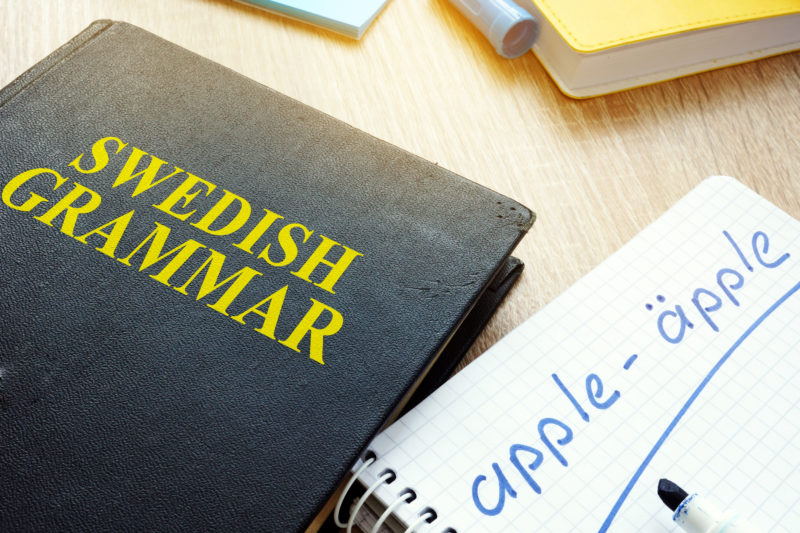Swedish Grammar Isn’t Hard to Learn
Nobody likes to learn grammar. Even for languages as easy as Swedish. Still, these rules are a necessary part of speaking Swedish correctly. Luckily, there’s not a lot to Swedish grammar. Native English speakers will understand a lot of the logic behind the language intuitively. But, let’s break down Swedish grammar to its components so you’re familiar with how the language works.
Swedish and English Are Related
Before we even begin, it’s worth noting that English and Swedish are related. Both are Germanic languages. Granted, English is West Germanic and Swedish is North Germanic. Still, a lot of the vocabulary and grammar are shared between the two languages. So, it will be easy to learn about these grammatical rules. Swedish grammar is nothing to be afraid of.
Swedish Cases
A lot of Germanic languages have cases. German, for example, has four separate cases, and inflections mark them. This used to be the case (pun intended) for Swedish too, but not anymore. Today, Swedish only has two cases.
- nominative
- genitive
The nominative case is the basic, normal, usual case for words. You don’t even have to think about it, because it’s just like it is in English. And the genitive case signals possession. Here, you need to use a simple inflection to show that the noun is in the genitive case. Just like the English ‘s that signals possession, adding -s does the same in Swedish. Simple as that. Told you Swedish grammar is nothing to be afraid of.

The Grammar of Swedish Nouns
Unlike in English, nouns in Swedish have genders. There are two genders in Swedish: the common gender and neuter. The common gender used to be masculine and feminine. But, over the history of the Swedish language, they merged together. Today, there are still some Swedish dialects that use separate genders, but standard Swedish doesn’t, so there’s no point in learning them. Just concentrate on the common and the neuter genders.
Articles in Swedish Grammar
In English, the definite article is “the” and the indefinite articles are “a” and “an”. But, Swedish articles are different. Sometimes they aren’t even separate words.
Definite Articles Are Suffixes
In Swedish, the definite article isn’t a word in front of the noun. Instead, the definiteness is marked as a suffix that’s attached to the end of the noun. And, you also need to make sure the suffix you add matches the number and the gender of the noun too. While this isn’t really that complicated, it’s definitely something you need to get used to.
Common Gender |
Neuter |
|
Singular |
-en / -n
|
-et / -t |
Plural |
indefinite plural + -na
|
indefinite plural + -a (if word ends in vowel) -en (if word ends in consonant) |
Let’s look at an example of these: kvinna (c) is woman and barn (n) is child:
- kvinnan – the woman
- barnet – the child
- kvinnorna – the women
- barnen – the children
Indefinite Articles Are Separate Words
You can breathe again. Indefinite articles are just like in English, separate words in front of the noun. But, you do need to match the gender of the noun, so you have two options for indefinite articles in Swedish grammar.
Common Gender |
Neuter |
|
Singular |
en
|
ett |
Here are the same examples for the indefinite article in Swedish.
- en kvinna – a woman
- ett barn – a child

Verbs in Swedish Grammar
Conjugating verbs in Swedish is actually easier than in English. There’s only one form for each verb for each tense. So, you don’t have to worry about the pronoun at all. They’re all the same. However, when you put it in past or future tense, you do need to change the structure of the verb a bit.
|
English conjugation |
Swedish conjugation |
|
I runyou run he runs she runs it runs we run you run they run |
jag springerdu springer han springer hon springer det springer vi springer ni springer de springer |
When you put the same verb into different tenses, you can see that Swedish grammar behaves the same way as English does. Even down to the “to have” and “will” auxiliary verbs.
- Jag sprang – I ran
- Jag har sprungit – I have run
- Jag kommer springa – I will run
The only big difference in Swedish is that the negation marker comes after the verb, not before it. “Inte” is the common negation market in Swedish.
- I didn’t run. – Jag sprang inte.
The Grammar of Pronouns Is Different in Swedish
Since we’re already here, let’s take a look at the grammar of Swedish pronouns. They’re a little different in Swedish. And not just because they need to be translated. The logic and the categorization is different too. The gender difference in common and neuter is evident when you’re saying it. And 2nd person plural isn’t just you plural. It’s also the way to address someone politely.
Swedish Pronouns |
English Meaning |
|
jag
|
I
|
|
du
|
you singular
|
|
han
|
he
|
|
hon
|
she
|
|
hen
|
gender-neutral third-person singular
|
|
den
|
it for common gender
|
|
det
|
it for neuter gender
|
|
vi
|
we
|
|
ni
|
you plural or polite
|
|
de
|
they
|
Swedish Adjectives
When you attach an adjective to a noun in Swedish, it has to match the noun. The number and the gender of the noun need to be represented. And this happens by adding the appropriate suffix to the end of the adjective. Here are all the options for inflecting adjectives.
Common Gender |
Neuter |
|
Singular |
∅ | -t / -tt |
Plural |
-a |
|
Let’s take a look at different examples of the adjective snabb (fast):
- snabb kvinna – fast woman
- snabbt barn – fast child
- snabba kvinnor – fast women
- snabba barn – fast children
Comparative Adjectives in the Swedish Language
Is the woman faster than the child? If you want to compare two adjectives in Swedish, you need to change the form of the adjective a little bit. In English, there are two ways you can make an adjective comparative: by adding the -er suffix to the end or adding more before the words. In Swedish, it’s almost the same process.
- add -are if the adjective is a single syllable (trevligare – nicer)
- add the word mer if the adjective is 3+ syllables (mer utmattad – more exhausted)
Superlatives in Swedish
Who’s the fastest? Sometimes you need to talk in superlatives. So, when you want to show that an adjective has reached the end of the scale, you need to add -ast(e) or -sta at the end. And if the noun is a definite noun, you also need to put an -e at the end of that.
- snabb – fast
- snabbare – faster
- snabbast – fastest
- snabbaste – the fastest
The Word Order of Swedish Sentences
Just like in English, basic word order in Swedish grammar is SVO (subject-verb-object). So, once you know a couple of useful Swedish vocabulary words, creating a sentence will be easy.
I ate the apple. – Jag åt äpplet.
You can see the similarities between English and Swedish. “Ate” and “apple” are almost spelled the same. And the sentence structure remained untouched too. The only noticeable difference is the lack of a definite article. But, you know how that works already in Swedish grammar.
Learn Swedish Grammar Naturally
Grammar lessons are always a little dry. Luckily, with Swedish, you don’t have to spend a lot of time learning new concepts. Most of them will be familiar to you. But, you should definitely grow your Swedish vocabulary more. And what better way to do that than learning it with OptiLingo?
OptiLingo is an app that includes the most useful and essential Swedish words and phrases. This list is the same that Swedish locals use. So, if you want to know how to talk to them, you need OptiLingo. Avoid spending time on unnecessary Swedish lessons. Cut straight to the point by downloading OptiLingo!








